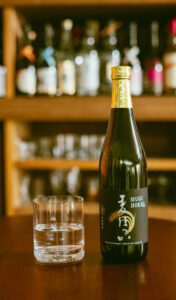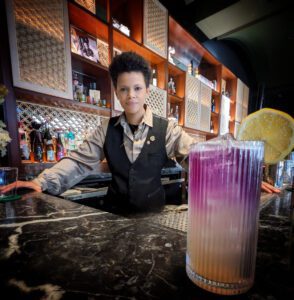Japan’s national spirit is finding its place stateside.


The new spirit showing up on many backbars in Atlanta is by no means “new.” Shochu (show-chew) dates to the 16th century in Japan, where it currently outsells sake and whisky. It’s only taken a few hundred years, but we are catching on to the intriguing spirit so revered in Japan.
Honkaku Shochu is especially intriguing because it tastes like and has the aromas of what it is made from. Its rich and versatile profile makes it satisfying sipped neat, on the rocks and as a base for cocktails. Unlike vodka, the unique crafting process lends a depth of flavor to the spirit. And compared to vodka, a 2-ounce serving of shochu has about 35 calories compared to vodka’s 120. It has no sugar.
There is often confusion with similar sounding spirits listed together on Asian menus. Shochu is not soju. Soju is a Korean spirit that is column distilled much like vodka, diluted down and dosed with artificial sweeteners. “It couldn’t be more different than shochu,” says Christopher Pellegrini, shochu expert and author of The Shochu Handbook, considered the foremost work on the subject.

Honkaku shochu can only legally be made with the traditional pot still, and additives such as coloring or flavoring are never permitted. The only approved ingredients in production are koji, yeast and water. Shochu, like sake, is fermented from approved ingredients and their koji (the same ingredient used to make miso, mirin and soy sauce).
Each part of the process, from fermentation, distillation and aging, contributes to the final product. “The two-stage fermentation process typically takes 2.5 to 3.5 weeks, after which the pot still is used just once to create a spirit that smells and tastes like the ingredients used to make it,” Pellegrini says. This fresh shochu is then aged in tanks, clay pots or oak barrels before bottling.
“There are 53 approved ingredients for the base of authentic shochu production, but the most commonly used are sweet potato, barley, rice, kokuto sugar, buckwheat (soba) and sake lees (the nutritional byproduct of sake production),” Pellegrini says. Because it is made from so many different ingredient bases, there is tremendous diversity in bottles of shochu. It has countless varieties of aromas and flavors, not only by the ingredient base, but the type of still used. Unlike vodka, the crafting process can add depth of flavor.

Shochu is intriguing for bartenders to play with in cocktails as it blends harmoniously with a variety of ingredients. Rice shochu lends clean notes, while potato shochu gives an earthy punch. Green tea shochu can be pleasingly astringent, while barley notes are nutty and roasty. Sweet potato and barley shochu sales make up 90% of the market in Japan.
In addition to local spirits shops, shochu is finding footing in Atlanta sushi spots. Mujō bartender Michael Satusky mixes a refreshing Hojiso Highball with rice-based Kome Shochu. It works well with shiso syrup, lemon and umeboshi (preserved plum), melding flavors and elevating freshness. Omakase Table offers flights to taste different shochu expressions.
At Buckhead’s Brush Sushi, Beverage Director Mona McAllen often chooses a “nice and light” shochu for a cocktail base. Ginrei Shiro Honkaku Shochu, made from rice koji, is mild and smooth with a long, citrusy finish. McAllen likes to make riffs of classics. Her Eastern Eclipse is a nod to a specialty drink popular in Japan called Chu Hi. McAllen blends shochu, baijiu (a fermented Chinese liquor), peach tea, pineapple, lemon and butterfly pea flower. “I named it for the shochu and baijiu origins and the nightfall effect that happens when stirring in butterfly pea flower tea,” she says.
BRUSH SUSHI
404.500.1888
brushatl.com
@brushatl
MUJŌ
404.400.6832
mujoatl.com
@mujoatl
OMAKASE TABLE
347.977.7229
omakasetableatl.com
@omakasetable.atl













